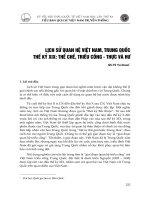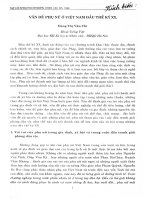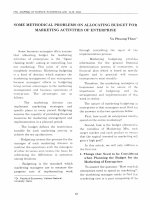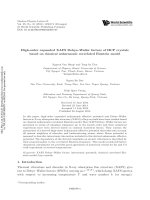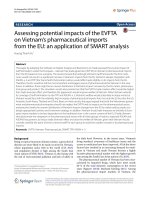DSpace at VNU: Heterogeneous Credit Impacts on Health Care Spending of the Poor in Peri-Urban Areas, Vietnam: Quantile Treatment Effect Estimation
Bạn đang xem bản rút gọn của tài liệu. Xem và tải ngay bản đầy đủ của tài liệu tại đây (292.33 KB, 5 trang )
679235
research-article2016
SGOXXX10.1177/2158244016679235SAGE OpenDoan et al.
Article
Heterogeneous Credit Impacts on Health
Care Spending of the Poor in Peri-Urban
Areas, Vietnam: Quantile Treatment
Effect Estimation
SAGE Open
October-December 2016: 1–5
© The Author(s) 2016
DOI: 10.1177/2158244016679235
sgo.sagepub.com
Tinh Thanh Doan1,2, Gibson John2, and Tuyen Quang Tran1
Abstract
Quantile treatment effects are estimated to study the impacts of household credit access on health spending by poor
households in one District of Ho Chi Minh City, Vietnam. There are significant positive effects of credit on the health budget
shares of households with low health care spending. In contrast, when an average treatment effect is estimated, there is
no discernible impact of credit access on health spending. Hence, typical approaches to studying heterogeneous credit
impacts that only consider between-group differences and not differences over the distribution of outcomes may miss some
heterogeneity of interest to policymakers.
Keywords
credit, health-care budget share, quantile treatment effect
Introduction
The impacts of access to credit on poor household’s consumption and health have been widely studied (e.g., Coleman,
1999; Nguyen, 2008; Pitt & Khandker, 1998; Pitt, Khandker,
Chowdhury, & Millimet, 2003). However, the literature concentrates on finding average treatment effects (ATE), which
assumes that all of the treated households get the same impact
from program participation. Studies in other settings show
that treatment effects can vary widely, not only across subgroups but also along the distribution of outcomes (Bitler,
Gelbach, & Hoynes, 2006, 2008; Djebbari & Smith, 2008).
This evidence of varying treatment effects is not just an
econometric curiosity; it also accords well with what may
interest policymakers. For example, finding that a credit program had much larger impacts for male borrowers would
likely prove influential if policymakers were interested in
closing gender gaps. Hence, a theme in the literature evaluating impacts of credit is to compare average treatment effects
for sub-groups defined by observable characteristics (e.g.,
age, education, and gender). However, the similarly interesting comparison of whether the impact is the same along the
outcome distribution, such as for households with already
high consumption versus those with low consumption, or
already high health care spending versus the low health care
service spenders, is rarely done. This sort of heterogeneity in
treatment effects can be studied using a quantile treatment
effects (QTE) estimator.
In this article, we report QTE estimates of the impact that
access to credit has on the health care spending of poor
households in peri-urban Vietnam. We used a survey
designed by the authors and applied to a sample of poor
households that are all under the urban poverty line.1 Hence,
in typical approaches to studying heterogeneity in treatment
effects, this sample would be one identifiable sub-group,
who would have an average treatment effect estimated and
assumed to apply to all members of the group. Our estimated
results show that such an approach hides considerable
within-group heterogeneity in the treatment effects.
The remainder of this note is organized as follows. The
next section describes the data collection and estimation
framework. The empirical results are reported in Section 3,
and the final section concludes.
Data and Analytical Framework
A sample of 411 borrowing and non-borrowing households
was interviewed in early 2008 in the peri-urban District 9,
1
Vietnam National University, Hanoi, Vietnam
University of Waikato, Hamilton, New Zealand
2
Corresponding Author:
Tuyen Quang Tran, University of Economics and Business, Vietnam
National University, Room 100, Building E4, 144 Xuan Thuy Road, Cau
Giay District, Hanoi 0084-4, Vietnam.
Email:
Creative Commons CC-BY: This article is distributed under the terms of the Creative Commons Attribution 3.0 License
( which permits any use, reproduction and distribution of
the work without further permission provided the original work is attributed as specified on the SAGE and Open Access pages
( />
2
Ho Chi Minh City, Vietnam. Because our focus is on microcredit impacts on poor households, the sample was selected
from a list of poor households whose initial income per capita was below the HCMC general poverty line of Vietnam
Dong (VND) 6 million (approximately US$1 per day). The
target sample size was set at 500 households, including 100
reserves, to achieve a realized sample of 400. In fact, 411
households were successfully interviewed, accounting for
26% of the total number of poor households in each of the
selected wards in the district. The interviewed sample provides 304 borrowing households and 107 non-borrowing
households, with 2,062 members, 955 (46.3%) males and
1,102 (53.7%) females. The sample is likely to be representative for the poor group whose initial income per capita is
below the poverty line at the survey time in the district but
will not be representative for Ho Chi Minh City nor for
Vietnam.
The survey was designed to collect data on household and
individual demographic–economic variables, commune
characteristics, household durable and fixed assets, child
schooling and education expenditure, health care, food, nonfood, housing expenditure, and borrowing activities. I also
utilized global positioning system (GPS) receivers to collect
data on locations of households and facilities to measure distances from each household to facilities.
The surveyed areas are located in the most dynamic
region, Ho Chi Minh City, in Vietnam. The city is the biggest
economic–financial center of the country; it accounted for
only 6.6% of the country’s population in 2005 but one third
of its gross domestic product (GDP). The city economy has
recently been growing at above 10% per annum.
The surveyed district is the 5th lowest population density
district and one of the peri-urban districts of HCMC. When it
was established in 1997, the district relied heavily on agricultural production, but its economic structure has changed
drastically due to current fast industrialization and urbanization. The average growth rate of industrial production and
services has been very high for the period 1997-2008,
namely, 24.7% and 28.1% per year, respectively. The total
number of enterprises, approximately 400 in 1997, increased
to 1,658 in 2006. In addition, the district population growth
rate is very high; it increased 59% over the period 19972008. Population density within the surveyed district in 2008
is heterogeneous. Some wards are very highly populated, for
example, Phuoc Binh (PB; 18,981 people/km2), Tang Nhon
Phu A (TNPA; 6,546 people/km2), while others are relatively
low, for example, Long Phuoc (LP; 300 people/km2) and
Long Truong (577 people/km2). The main economic activities of the district are non-farm economic activities such as
industrial production, construction, and services. For our
sample, 72% of household heads are small traders, housewives, casual workers, factory workers, and the jobless.
We use a quantile regression (QR) estimator, which examines the effects of the regressors on the dependent variable at
various points on the conditional distribution of responses
SAGE Open
(e.g., at the 25th and 75th percentiles). The model specifies
the θth − quantile (0 < θ < 1) of conditional distribution of the
dependent variable; given a set of covariates xi, and assume
that residual distributions of each quantile are normally distributed, we have,
Qθ ( yi | Xi ) = α θ + Xi × βθ (1)
where yi is the outcome of interest (the budget share for
health care in this case) for household i, and xi is a set of
explanatory variables including an indicator for credit participation and variables measuring the household head’s sex,
age, marital status, and education, along with household size,
household expenditure, initial income and assets, and location of the dwelling. The treatment variable of interest is
credit participation, which equals one if a household had
received any loans in the 24 months prior to the survey and
zero otherwise. A total of 304 households were borrowers,
and 107 households were non-borrowers under this definition. The estimator (Equation 1) is the solution to the following minimization problem (see Cameron & Trivedi, 2009):
Q ( βθ ) = min
β
n
∑ y − X β
i
i θ
(2)
= min
θ | yi − xi βθ | +
(1 − θ ) | yi − xiβθ |
i: yi ≥ xiβ
i: yi < xi β
∑
i =1
∑
In other words, this is the solution to a problem where the sum
of the weighted absolute value of the residuals is minimized.
As θ is increased, the entire distribution of outcome y is traced,
conditional on xi. We estimate βθ for a particular θth quantile of
distribution rather than β. If we estimate β for θ, then much
more weight is placed on prediction for observations with y ≥
xi.β than for observations with y < xi.β (i.e., 1 − θ).
When QR is adapted to investigate heterogeneity in program impacts, the QTE of Heckman, Smith, and Clements
(1997) results. Let Y1 and Y0 be the outcome of interest for
the treated (1) and comparison groups (0). F1(y|xi) = Pr[Y1 ≤
y|xi] and F0(y|xi) = Pr[Y0 ≤ y|xi] are the corresponding cumulative distribution functions of Y1 and Y0 conditional on xi. If
θ denotes the quantile of each distribution, then yθ(T) = inf{y:
FT(y|x) ≥ θ}, T = 0, 1 (treatment status) where “inf” is the
smallest value of yθ that meets the condition in the braces.
For example, y0.25 = inf{y: FT(y) ≥ 0.25}, T = 0, 1. The quantile treatment effect at quantile θth is defined as Δθ = yθ(T = 1)
− yθ(T = 0), and the Δθ is the difference between the outcome
of interest for the treatment and comparison groups at a particular θth quantile. In other words, the QTE shows how the
treatment effect changes across specified percentiles of the
outcome distribution.
The QTE relies on the rank-invariance assumption, that
the relative value (rank) of the potential outcome for a given
household would be the same under assignment to either
treatment or comparison group (Firpo, 2007). However,
3
Doan et al.
Table 1. Monthly Average Health Care Expenditure of B and NB.
25th percentile
50th percentile
75th percentile
NB
B
B
B
220.84 (5.31)
63.17 (1.84)
M
B
Health Care 299.67 (6.43)
expenditure
NB
NB
12.08 (0.61) 119.67 (3.37) 69.67 (2.26) 290.42 (7.50)
NB
185.00 (6.06)
Note. The budget share for health care in the parentheses. B = borrowers; NB = non-borrowers.
Table 2. Quantile Regressions of Credit Impact on Budget Shares of Health Care Expenditure.
Explanatory
variables
Credit dummy
Log size
Log PCX
Constant
Basic specification
0.25
0.0078 (0.002)**
0.0029 (0.0020)
−0.0021 (0.0015)
0.0110 (0.0114)
0.50
0.0060 (0.006)
0.0048 (0.006)
0.0004 (0.004)
0.0037 (0.032)
Extended model specification
0.75
−0.0009 (0.016)
0.0139 (0.013)
0.0287 (0.01)**
−0.1547 (0.063)*
OLS
0.25
0.0088 (0.011)
−0.0120 (0.014)
0.0303 (0.012)*
−0.1475 (0.082)†
0.0093 (0.002)
0.0020 (0.003)
−0.0037 (0.002)*
−0.0102 (0.027)
0.50
0.75
†
0.0115 (0.006)
0.0034 (0.007)
−0.0014 (0.005)
−0.0764 (0.052)
OLS
−0.0053 (0.016)
0.0114 (0.011)
0.0061 (0.014) −0.0108 (0.013)
0.0140 (0.012)
0.0252 (0.014)†
−0.3048 (0.133)* 0.3459 (0.133)*
Note. Bootstrap standard errors in parentheses with 1000 replications; OLS standard errors are robust. Dependent variable is the budget share for health spending; Log
size is the log of household size; Log PCX is monthly expenditure per capita (in log). The number of observations is 411 households. Both the basic and extended models
control for location dummies. The extended model specification further controls for head’s sex, age, marital status, education, and initial income per capita and assets. OLS
= ordinary least square.
†
Significant at 10%. *Significant at 5%. **Significant at 1%.
because outcomes for the same household may differ from
one distribution to another based on observable and unobservable characteristics, bounds have to be computed for the
QTE (Heckman et al., 1997). Even without rank invariance,
the QTE may still be meaningful as policymakers may be
interested in the marginal distributions of the potential outcomes. In such cases, QTE is simply the difference between
the same quantile of the marginal distributions of outcomes
for the treated households and for comparison group
households.
Heterogeneity in the outcome variable may correspond
either to variation across particular sub-groups (or cohorts)
in the population that would generate a local average treatment effect (LATE) or to impacts of unobservable characteristics (Angrist, 2004). In this article, we assume that we have
a homogeneous population, so there are no sub-groups that
would have the LATE (and for whom a particular instrumental variable might bind while it does not bind for others), and
that the heterogeneity in the outcomes comes from the random errors. Because we assume it is unobservables rather
than local treatment effects causing the heterogeneity, we do
not necessarily need an instrumental variable estimator
(which can be combined with the QTE to address bias from
selection on unobservable characteristics (Abadie, Angrist,
& Imbens, 2002)). If good instruments are available, the
QTE with instrumental variables (IQTE) may be more precise than the conventional IV estimator at the median (Abadie
et al., 2002) in addition to addressing the potential selection
bias. However, in previous results with the same data used
here, no good instruments are identified (Doan, Gibson, &
Holmes, 2014), so we rely on the assumption that the selection into the treatment is based on observables.
Empirical results
Table 1 presents unconditional differences in monthly average health care expenditure (in 1,000 Vietnam Dong) and in
the health care budget share. At all points in the distribution
of health care spending considered here, households who
were borrowers spent more on health than their non-borrowing counterparts. The households that borrowed had similar
initial income and assets to the non-borrowers, but higher
current total monthly consumption (appendix). So, one possible reason for higher health care spending might be that the
same budget share generates more spending for richer households. However, in fact, that is not the case; the borrowing
households also are devoting larger shares of their budgets to
health at all points in the distribution.
To see whether the higher health care spending of borrowers across the distribution persists when we condition on
explanatory variables, we estimate QTE at the 25th, 50th,
and 75th percentiles (Table 2). The table also presents ordinary least squares (OLS) estimates in the final column of
each panel. The explanatory variables used are listed in the
appendix. Our basic specification includes location, household size, and expenditure per capita in addition to the credit
participation treatment variable, while an extended specification adds the gender, age, marital status, and education of
the household head, and pre-treatment values of income per
capita and assets.2
In both the basic and extended specifications, there is considerable heterogeneity in the treatment effects of credit on
the health care budget share (Table 2). For households with
health budget shares below the median, access to credit is
associated with significantly higher health care spending.
4
SAGE Open
However, for households above the median, health care
spending goes down (insignificantly) when a household is a
borrower. The same pattern is observed when using the
extended model specification. In neither case would these
effects be apparent when using OLS.
Thus, it appears that access to credit increases the health
care budget share of households who had lower health care
budget shares prior to their credit participation. This positive
effect of credit is hidden when estimating an average treatment effect, although the sample is for a homogeneous group
of urban households from one district who are all below the
poverty line.
There also appears to be some heterogeneity in the effect
of per capita household expenditure (used as a proxy for permanent income) on the health care budget share. The OLS
estimates suggest that the health care budget share rises by
about three percentage points for every one log point increase
(approximately two standard deviations) in per capita expenditure. However, this hides an effect (which is statistically
significant in the extended specification) of the budget shares
falling with higher expenditure at the 25th percentile.
Conclusion and Limitations
Treatment effects can vary widely, not only across sub-groups
but also along the distribution of outcomes. In this note, we provide an example where our sample is all under the urban
poverty line and would typically be considered one identifiable
sub-group, for which an average treatment effect would be estimated. Yet we find considerable heterogeneity in treatment
effects within this seemingly homogeneous sample, which
would be hidden if we only reported an average treatment effect.
Specifically, although OLS estimates of ATE show no significant effect of credit participation on health care budget
shares, the QTE estimates show that credit has positive
impacts on health care budget shares for households with
low levels of health care spending. From a policy point of
view, this suggests that facilitating access to credit sources
may be a significant factor in improving health status of the
urban poor, and the policy may work better if it is better
designed targeting the right families who need the help most.
Land loss (due to urbanization) may be an issue in fast
growing/urbanizing areas in HCMC as well as in other big
cities in Vietnam and where the capital market is less developed then informal sector has a role to play in which interpersonal relationship or social capital may affect the access
to credit. It may be appropriate to instrument the credit access
by these factors in an IV model. This limitation opens up a
venue for future study. Furthermore, our study focuses on
peri-urban areas of HCMC, the biggest city. However, the
households in big cities may be different from those in
smaller cities as well as in other regions of the country where
socioeconomic conditions are fairly diversified. As a result,
our results may not be representative of the whole country.
Appendix
Descriptive Statistics and t Values for Equal Means by Borrowing Status.
Borrowers
Variables
Variable for basic specification
Monthly health care expenditure
Health budget share
Household size in log
Total monthly expenditure
Monthly expenditure per capita in log
Location
Tang Nhon Phu A (Yes = 1)
Long Truong (Yes = 1)
Long Phuoc (Yes = 1)
Phuoc Binh (Yes = 1)
Additional variable for extended specification
Head’s sex (male = 1)
Head’s education (year)
Married (yes = 1)
Head’s age (year)
Initial assets including land and assets in log
Initial income per capita in log
Observations (households)
Non-borrowers
M
SD
M
SD
299.671
0.064
1.554
4,416
6.691
582.295
0.092
0.440
2,738
0.484
220.840
0.053
1.354
3,602
6.611
551.908
0.093
0.577
2,597
0.596
0.188
0.313
0.322
0.178
0.391
0.464
0.468
0.383
0.299
0.234
0.243
0.224
0.460
0.425
0.431
0.419
2.24*
1.61
1.60
1.01
0.507
4.911
0.648
52.901
13.183
8.161
0.501
3.350
0.478
13.97
1.243
0.227
0.505
4.664
0.607
59.467
12.977
8.114
0.502
3.760
0.491
15.46
1.667
0.347
0.03
0.60
0.74
3.87**
1.17
1.31
304
107
Note. Assets, income, and expenditures are measured in VND 1,000. These variables are used in models in Table 2. VND = Vietnam Dong.
t value statistically significant at †10%. *5%. **1%.
t Value
1.25
1.07
3.26**
2.75**
1.25
5
Doan et al.
Acknowledgments
We thank two anonymous referees and the editor for their helpful
comments, which significantly improved the quality of our article.
Declaration of Conflicting Interests
The author(s) declared no potential conflicts of interest with respect
to the research, authorship, and/or publication of this article.
Funding
The author(s) received no financial support for the research and/or
authorship of this article.
Notes
1. Set at six million Vietnam Dong per person per year, which is
equivalent to just under US$1 per day.
2. Descriptive statistics for these variables and the tests of their
differences between borrowers and non-borrowers are presented in the appendix.
Doan, T., Gibson, J., & Holmes, M. (2014). Impact of household
credit on education and healthcare spending by the poor in periurban areas, Vietnam. Journal of Southeast Asian Economies,
31(1), 87-103.
Firpo, S. (2007). Efficient semiparametric estimation of quantile
treatment effects. Econometrica, 75, 259-279.
Heckman, J., Smith, J., & Clements, N. (1997). Making the most out
of programme evaluations and social experiments: Accounting
for heterogeneity in programme impacts. Review of Economic
Studies, 64, 487-535.
Nguyen, V. C. (2008). Is a governmental micro-credit program
for the poor really pro-poor? Evidence from Vietnam. The
Developing Economies, 46, 151-187.
Pitt, M., & Khandker, S. (1998). The impact of group-based credit
programs on poor households in Bangladesh: Does the gender of
participants matter? Journal of Political Economy, 106, 958-992.
Pitt, M., Khandker, S., Chowdhury, O., & Millimet, D. (2003).
Credit programs for the poor and the health status of children in
rural Bangladesh. International Economic Review, 44, 87-118.
Author Biographies
References
Abadie, A., Angrist, J., & Imbens, G. (2002). Instrumental variables estimation of quantile treatment effects. Econometrica,
70, 91-117.
Angrist, J. (2004). Treatment effect heterogeneity in theory and
practice. Economic Journal, 114, 52-83.
Bitler, M. P., Gelbach, J., & Hoynes, H. (2006). What mean impacts
miss: Distributional effects of welfare reform experiments.
American Economic Review, 96, 988-1012.
Bitler, M. P., Gelbach, J. B., & Hoynes, H. W. (2008). Distributional
impacts of the self-sufficiency project. Journal of Public
Economics, 92, 748-765.
Cameron, A., & Trivedi, P. (2009). Microeconometrics using stata.
College Station, TX: StataCorp LP.
Coleman, B. (1999). The impact of group lending in Northeast
Thailand. Journal of Development Economics, 60, 105-141.
Djebbari, H., & Smith, J. (2008). Heterogeneous program impacts
in PROGRESA. Journal of Econometrics, 145, 64-80.
Tinh Thanh Doan is a research associate at the Waikato
Management School and Research Fellow at University of
Economics and Business, Vietnam National University, Hanoi. His
research interests include household welfare and policy impact
evaluation.
John Gibson is Professor of Economics at the Waikato Management
School. His teaching and research interests are in microeconomics
and in the micro econometric aspects of development, labour and
the international economy. He is a member of an expert group
advising the United Nations Statistical Division, the design and
analysis of household survey data, and economic development,
especially in China and other Asian and Pacific economies
Tuyen Quang Tran is a senior lecture in political economy at
University of Economics and Business, Vietnam National University,
Hanoi. He is a member of National Foundation for Science and
Technology Development. His research interests include household
welfare, firm performance, institution and development.
